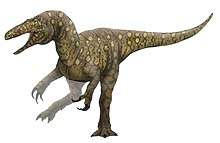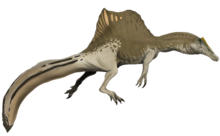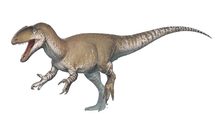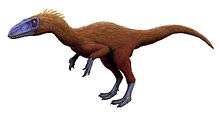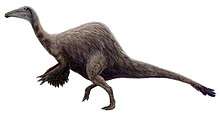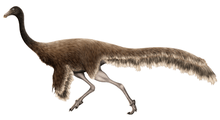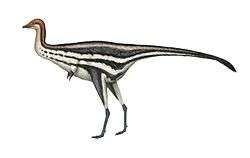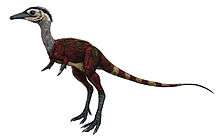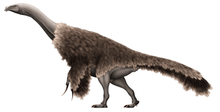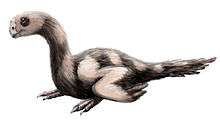Neovenatoridae
Neovenatoridae is a family of large carnivorous dinosaurs representing a branch of the allosauroids, a large group of carnosaurs that also includes the sinraptorids, carcharodontosaurids, and allosaurids. Compared to other allosauroids, neovenatorids had short, wide shoulder blades, and their ilia (upper hip bones) had many cavities.[1] They lived in Africa, Asia, Europe, South America and North America.
| Neovenatorids | |
|---|---|
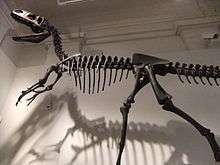 | |
| Restoration of Neovenator salerii | |
| Scientific classification | |
| Kingdom: | Animalia |
| Phylum: | Chordata |
| Clade: | Dinosauria |
| Clade: | Saurischia |
| Clade: | Theropoda |
| Clade: | †Carcharodontosauria |
| Family: | †Neovenatoridae Benson, Carrano & Brusatte, 2010 |
| Type species | |
| †Neovenator salerii Hutt, Martill, & Barker, 1996 | |
| Subgroups | |
Classification
Phylogenetic studies conducted by Benson, Carrano and Brusatte (2010) and Carrano, Benson and Sampson (2012) recovered the group Megaraptora as members of the Neovenatoridae. This would make neovenatorids the latest-surviving allosauroids; at least one megaraptoran, Orkoraptor, lived near the end of the Mesozoic era, dating to the early Maastrichtian stage of the latest Cretaceous period, about 70 million years ago.[1][2] On the other hand, Novas et al. (2012), while confirming that Neovenator was closely related to carcharodontosaurids, simultaneously found Megaraptor and related genera to be coelurosaurs closely related to tyrannosaurids.[3] However, Novas et al. subsequently found that megaraptorans lacked most of the key features in the hands of derived coelurosaurs including Guanlong and Deinonychus. Instead, their hands retain a number of primitive characteristics seen in basal tetanurans such as Allosaurus. Nevertheless, there are still a number of traits that support megaraptorans as members of the Coelurosauria.[4]
The cladogram below follows a 2016 analysis by Sebastián Apesteguía, Nathan D. Smith, Rubén Juarez Valieri, and Peter J. Makovicky based on the dataset of Carrano et al. (2012).[5]
| Allosauroidea |
| ||||||||||||||||||||||||||||||||||||||||||
References
- Benson, R.B.J.; Carrano, M.T; Brusatte, S.L. (2010). "A new clade of archaic large-bodied predatory dinosaurs (Theropoda: Allosauroidea) that survived to the latest Mesozoic". Naturwissenschaften. 97 (1): 71–78. Bibcode:2010NW.....97...71B. doi:10.1007/s00114-009-0614-x. PMID 19826771.
- Matthew T. Carrano, Roger B. J. Benson and Scott D. Sampson (2012). "The phylogeny of Tetanurae (Dinosauria: Theropoda)". Journal of Systematic Palaeontology. 10 (2): 211–300. doi:10.1080/14772019.2011.630927.
- F. E. Novas; F. L. Agnolín; M. D. Ezcurra; J. I. Canale; J. D. Porfiri (2012). "Megaraptorans as members of an unexpected evolutionary radiation of tyrant-reptiles in Gondwana". Ameghiniana. 49 (Suppl.): R33.
- Novas, F.E.; Rolando, A.M.A.; Agnolin, F.L. (2016). "Phylogenetic relationships of the Cretaceous Gondwanan theropods Megaraptor and Australovenator: the evidence afforded by their manual anatomy" (PDF). Memoirs of Museum Victoria. 74: 49–61. Archived from the original (PDF) on 2016-08-18.
- Sebastián Apesteguía; Nathan D. Smith; Rubén Juárez Valieri; Peter J. Makovicky (2016). "An Unusual New Theropod with a Didactyl Manus from the Upper Cretaceous of Patagonia, Argentina". PLoS ONE. 11 (7): e0157793. Bibcode:2016PLoSO..1157793A. doi:10.1371/journal.pone.0157793. PMC 4943716. PMID 27410683.
